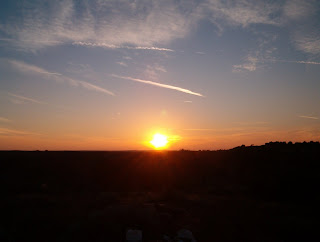Though we've spent most of the dig focusing on creatures that are long dead, we also enjoyed the surprisingly numerous beautiful, living creatures and sights around the site.





+of+olmpPFE+175.JPG)

Of course, it's not all natural beauty. You have to look out for some things.



Lots of people understandably - and probably wisely - recoil from the spiders, snakes, centipedes and the other creepy things crawling around, over and through the fossils, David has a surprising affinity for them.

The wide, Texas sky just goes on and on. We were lucky to have weather like this all week. It makes you realize how little of the sky you actually see in the city - but in Seymour, it's everywhere. You can't miss it. And at night, the stars...well, they just inspire this amazing, lasting sense of dumbfounded wonder. It's a sight that simply can't be captured by a photograph.

Oddly, most of the people on the team harbor at least a small crush on insects in addition to their passion for paleo - manifest most intensely in David, who is constantly on the lookout for new specimens he can take back for the live insect collection at the Museum. Seeing insects like this one up close, just walking around, going about their business in nature, is a totally unique experience.

A collared lizard is a rare sight - and it's even more rare to catch them gaping on film. These little guys have a lot of personality and they are so cool to watch.

These thistles look like someone literally dipped them in purple ink. As they're the only color more vivid than tan on this entire landscape (actually, Mineral Wells, about 100 miles south of Seymour), coming upon them suddenly can take your breath away. Of course, that might have been all the hiking and leaping across ravines. But I'm pretty sure it was the thistles.

Cows make me laugh. I don't know why. Maybe it's their unblinking curiosity at whatever they come across - along with their simple, stubborn refusal to be moved by whatever it happens to be. You just can't impress a cow. We didn't see too many at the beginning of the week, and I didn't realize how much I missed them until they came back.
+of+olmpPFE+175.JPG)
These grasshoppers blend perfectly and sedately into the landscape - until they suddenly decide to take a wild leap through space. Can you imagine what it would be like to jump like that on a human scale?

The sunsets are unbelievable - and different every day.
Of course, it's not all natural beauty. You have to look out for some things.

So, I should have known this, but I just discovered a fun little fact on this trip. Rattlesnakes are deadly. Sure, hospitals have the antivenom - but what are you going to do if you get bit by one in the middle of a ranch, at least an hour away from the nearest medical facility?
And how's this for comforting? I just heard a story on the radio, quoting a passage from one of Theodore Roosevelt's writings, in which the future president witnesses a young girl get bitten in the leg by a rattlesnake. She falls to the ground, screaming, at which point the rattlesnake bites her again - in the neck. She died.
Rattlesnakes do not mess around. Neither should you.
And how's this for comforting? I just heard a story on the radio, quoting a passage from one of Theodore Roosevelt's writings, in which the future president witnesses a young girl get bitten in the leg by a rattlesnake. She falls to the ground, screaming, at which point the rattlesnake bites her again - in the neck. She died.
Rattlesnakes do not mess around. Neither should you.

Mineral Wells was crawling with these. You might not be able to tell from this picture, but they are HUGE. And if the bright red color isn't warning enough, check out the close up below.

Look at the pinchers on this guy! They're as big as his head.
Lots of people understandably - and probably wisely - recoil from the spiders, snakes, centipedes and the other creepy things crawling around, over and through the fossils, David has a surprising affinity for them.
David collects an orb weaver spider, for the live insect collection at the Museum. The weather was turning so cold, he was afraid the spider might not survive. When it warmed up - and the spider turned listless in captivity - David released it back into the wild.

2 comments:
I don't think the bearded lizard is a bearded lizard. I think it's a collared lizard, Crotaphytus c. collaris.
You're absolutely right - I checked with our zoology staff at the Museum and this photo is of an Eastern Collared Lizard, Crotaphytus collaris collaris. Thanks for catching my error!
Erin
Post a Comment